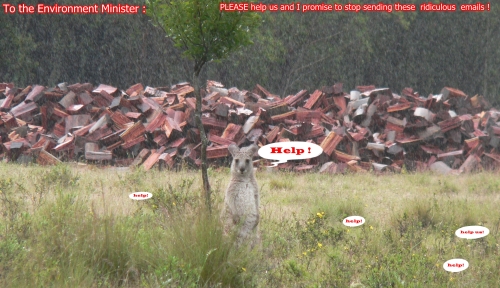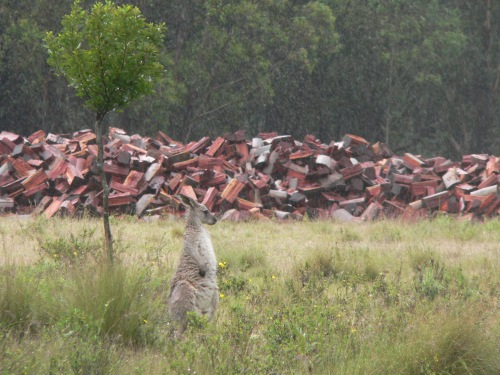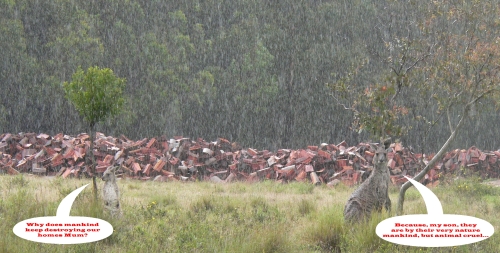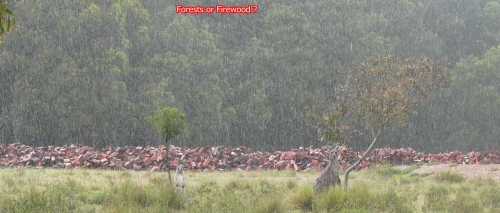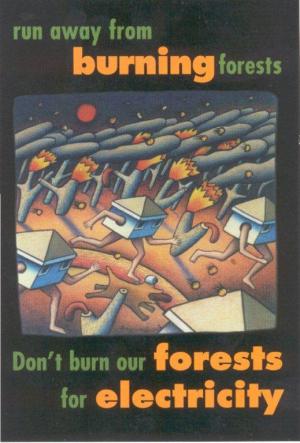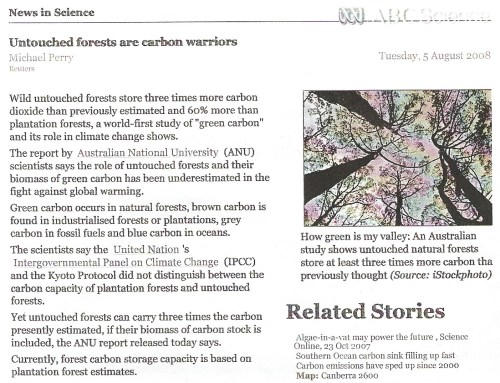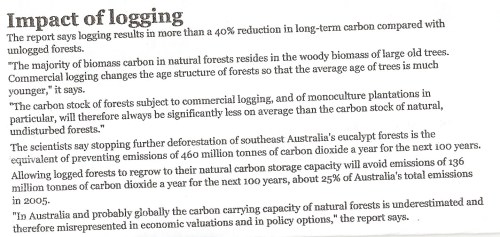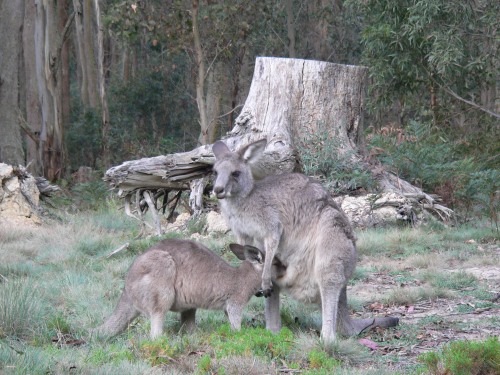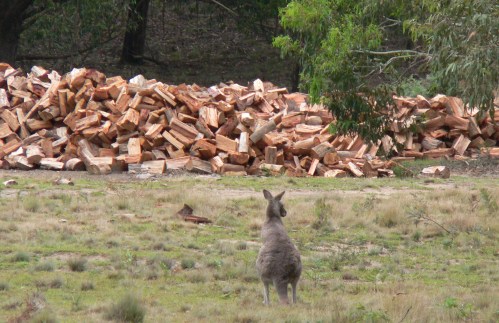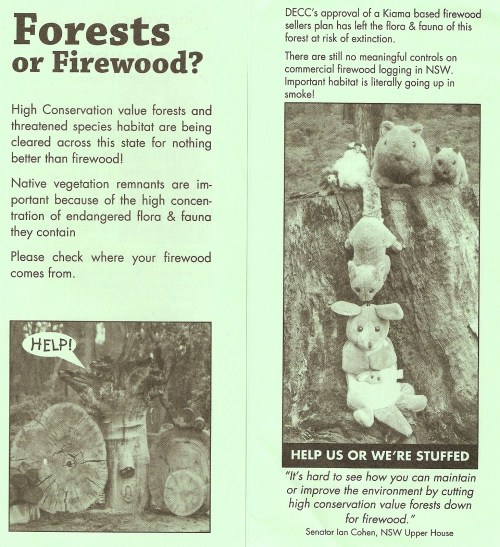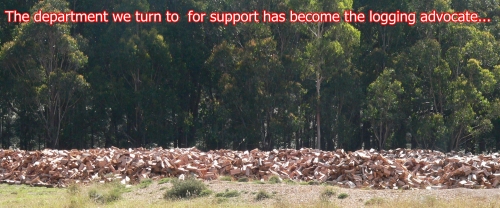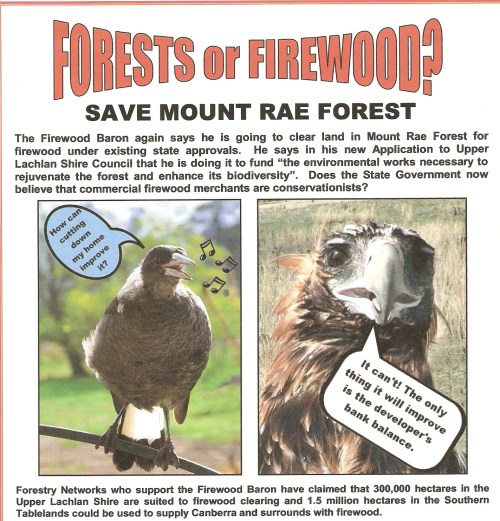“God has cared for these trees , saved them from drought, disease, avalanches and a thousand tempests and floods . But he cannot save them from fools” John Muir
High Conservation Value forests are being cleared in NSW for nothing better than commercial firewood with the full knowledge and apparent approval of the Office of Environment and Heritage. Important threatened species habitat is going up a chimney.
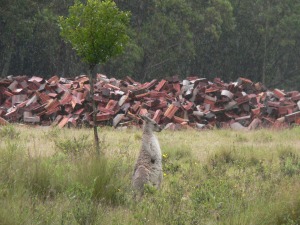
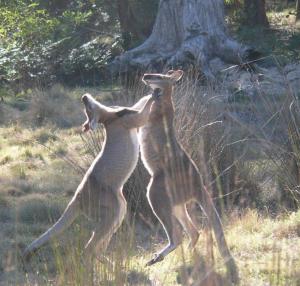 A CSIRO study (2001?) produced information on firewood use in Australia. It estimated that firewood consumption by Australian households at around 5 million tonnes.
A CSIRO study (2001?) produced information on firewood use in Australia. It estimated that firewood consumption by Australian households at around 5 million tonnes.
When industrial firewood is included this total annual consumption is around 6-7 million (partly dry) tonnes . Compare this with Australian hardwood chip exports of 3.6 million “bone dry” tonnes or 7 million “green” tonnes in the same year of study . (1999-2000). This CSIRO study also noted that firewood harvesting in dry forests and woodlands was at rates well above a sustainable level.
The interim Private Native Forestry (PNF) interim code of practice which is currently allowing commercial firewood logging in Mount Rae Forest is predicted to pass through NSW parliament in 2012 and be passed into forestry law.
It is ironic that these forests on private lands containing some of the best wildlife and threatened species remnants and habitat in NSWare called the “FORGOTTEN FORESTS” ,whilst those involved in the above firewood study, aware of how so many dismiss firewood use as insignificant ,called it the “FORGOTTEN FORESTRY” of Australia.
The forests and woodlands of the Southern Tablelands had been LARGELY PROTECTED IN THE PAST as they were not considered to have much left that is considered millable and of saw log quality . The area has been highly modified for agriculture and most were being encouraged to plant trees , join landcare and protect the remaining remnants for their biodiversity values.
In the north of the State “much of the private forest landscape contains extensive areas of unmerchantable timber which is the result of past’high grading’ logging operations. This is where the best timber trees are removed over a number of logging cycles , the end result is a forest comprised mostly of twisted defective old trees, generally considered unmerchantable by timber contractors .”(source-North Coast Environment Council-NCEC ) .
These areas of course now represent important habitat supporting high biodiversity values.
Forestry interests and the timber industry have now been urging landholders to undertake silvicultural treatments across their lands to improve the forest structure for future timber yields. (This is the “improvement” they constantly claim they will achieve-improving the bank balance but not biodiversity) .
It would appear that the removal of habitat -which foresters describe as defective trees and nothing more than waste – has been largely prevented as there has been no real economic returns. It had been a concern to many that if biomass energy or wodchipping infrastructures were available that these would become the economic driver for large scale ‘silvicultural improvements’ to occur and result in increased PNF activities.
Not many thought that the Southern Tablelands would be targetted as the new firewood capital of NSW.
The firewood merchant in Mount Rae forest has described the purpose of his logging as helping to make available “funds to conduct the silvicultural operations and environmental works necessary to rejuvenate the forest and enhance it’s biodiversity” .
The STFFN claims of support from the Australian National University is the Fenner School of Forestry . This quote is from an abstract presented at an Australian Forest Growers National Conference on the privately owned forests of Australia . “The form of trees is poor from a utilisation perspective (and may reflect “high grading” in the past for particular species as well as form) and stands from which sawlogs can be obtained are rare. However , some stands may be useful for fencing and other rough farm -timber uses, particularly of firewood which may also be the highest dollar value for all timber wood values anyway.”
The STFFN have embarked on an extensive campaign to promote firewood as being greenhouse positive, renewable , eco-friendly and PNF as the most ‘benign ‘ of all agricultural practices. They claim biocertification by the Environment Minister through PNF as evidence of this. Firewood merchants are apparently the new conservationists. Mount Rae forest was to be the test case to ‘greenwash’ their plan to conduct these operations across the region to supply firewood to Canberra and Sydney markets. They now needed to convince the ‘uneducated’ public that firewood was greenhouse positive and renewable. That logging of native forests ecosystems would improve their bioidversity values.
PRIVATE NATIVE FORESTRY legislation has seen the promotion of these areas in the Southern Tablelands as FIREWOOD by the Southern Tablelands Forestry Network . Or might they be future biomass and woodchips? In fact a precedent has been set under this legislation for renewed clearing throughout the region for any reason at all.
A STFFN newsletter from 2001 revealed plans of developing a native timber co-operative for the Southern Tablelands , “Various products such as firewood, sawn timber and fence posts will potentially be sold from this location. “
Landowners with native forests could sign up for a stumpage rate for timber harvested by the co-operative .
The trees of the Tablelands are apparently no longer of value to our Government as carbon stores , biodiversity banks and buffers against erosion and sedimentation of waterways . They are not recognised as habitat. They are apparently nothing more than future firewood:
The above quotes come from STFFN literature. A newspaper advertisement in the Crookwell Gazette by the STFFN -MANAGING PRIVATE NATIVE FORESTS -stated :
“Due to the degraded nature of these forests , the wood products coming from them would be of low value. Products would be firewood , wood for charcoal production, and wood for bio-energy production , with a very occasional higher value sawlog… There is approximately 350,000 hectares of private native forests in the Upper Lachlan Shire Council area. If managed sustainably these forests could yield in excess of 700,000 tonnes of wood product per annum. This yield would displace 350,000 tonnes of coal usage for electricity , charcoal and heating , and potentially represent a greenhouse gas emission saving… ”
An article by the STFFN in their newsletter stated:
“The challenge lies with growers to successfully supply the market with a suitable product… Options for growing firewood : 1. MANAGING EXISITNG STANDS OF NATIVE TIMBER. There is more than 1.5 million hectares of existing native forest occuring on private land in the Southern Tablelands . Much of this area of land is accessible for small scale firewood harvesting operations. Under new State Government legislative reforms regarding private native forests , landholders will be able to conduct firewood operations …
Of course the STFFN opinions on firewoods environmental values never include the effects of habitat destruction and forget to mention that the carbon stored in native forests is allowed to be counted as zero in their accounting process and that firewood hardly stores carbon in the final product . It directly adds to carbon emissions at a time of predicted climate change. Waiting 150 -300 years for forestry to restore the carbon the have cut down may well be too late. Sending it up a chimney in repeated cycles is patently absurd. See some of the following research and science from others in the Australian National University School of Environment and Science :
Analysis of burning native forests for power as ‘biomass ‘electricity has shown this process produces significantly more carbon pollution than coal -fired power plants, releasing vast amounts of stored carbon into the atmosphere and exacerbating the costs of climate change.
Carbon emissions AND wildlife homes straight up a chimney. Hardly carbon storage…
The following is from an edition of “Wilderness News ” spring 2011. concerning claims that biomass should be regarded as ‘greenhouse neutral’ ( a STFFN proponent once claimed firewood logging in Mount Rae forest to be greenhouse positive) because new trees are grown to replace those that grow back. “the reality is it could take up to 800 years for new trees to sequester the carbon released by old growth logs burnt for power. ”
Whilst I have never claimed the forests of Mount Rae to be old growth ( though some trees in gullies supporting hollows for the Powerful owl demonstrate old growth characterisitics ) any regeneration of trees would be unlikely to sequest carbon in time to help mitigate the effects of burning them .I seriously doubt whether the firewood merchant in Mount Rae forest is conducting his operation to help climate change anymore than I believe statements that firewood logging is being undertaken to ‘improve ‘ the forest for biodiversity.
The July carbon package announced by the Federal Labour Government recognised that burning native forests for electricity generation should not be classifed as a’ renewable’. Lyndon Schneiders , Wilderness Society National Campaign director said ” The Australain Government has finally come to it’s senses by ruling that turning native forests intoa power source is not renewable and should not be supported”
Native forests provide far greater value for their ecosystem services and long term carbon storage. Continuing to allow them to be managed for silvicultural production will only see a continued loss of ecological value.
Many of those within rural areas source their own firewood and fenceposts sustainably for their own use. The NV act allows this . It may well be used for cooking and heating water as well as for winter warmth. Given the distances between many rural areas (I have 2 neighbouring dwellings within approx 3 kms) smoke dissipates and has negligible effects. However , increasing firewood use in reidential, low lying towns such as Canberra and Sydney, traps smoke and has a detrimental effect on health, particularly amongst the elderly and the very young. It is for this reason the American Lung Association has stated that “particles produced by wood fires can be toxic and dangerous to human health”. They provide clear evidence of increased risk of asthma , pulmonary inflammation and even premature death.
I am reliably informed that in Canberra less than 4% of households burn wood for domestic heating, yet the Federal Enviornment Dept. reports they are responsible for 71 % of Canberra’s particle air pollution, compared to cars at just 10%.
A recent ( Saturday 28th Jan 2012) Sydney Morning Herald newspaper article stated that wood smoke in Sydney is the biggest source of air pollution in winter , and wood smoke will add $8 billion to the health budget by 2030. The article went on to say ” A study in 2010 by the Environment Department found wood smoke pollutants could aslo affect rates of cancer , birth defects and nervous system disorders…In Sydney the proportion of people using wood to heat their homes is very small, yet it accounts for between 48 % and 60% of small particle pollution in winter.
Yet under PNF the government is sanctioning it’s sale at a commercial level to these very centres. The wildlife of the forest are appalled at the ongoing blatant hypocrisy…


